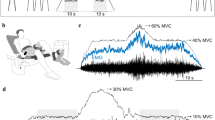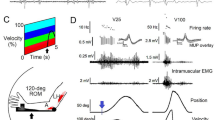Abstract
Subjects made a fast elbow extension movement to designated target in response to a go signal. In 45% of trials a stop signal was presented after the go signal, to which subjects were asked to stop the movement as rapidly as possible. The interstimulus interval (ISI), or time interval between the go and stop signals, was randomly varied between 0 and 200 ms. Electromyographic (EMG) activity was recorded from biceps brachii and triceps brachii. Subjects could sometimes completely inhibit initiation of the movements when the ISI was 0 ms, but could rarely do so when the ISI exceeded 100 ms. For responses that were initiated but stopped on the way, the amplitude of the movement decreased linearly as the time interval (=modification time) from the stop signal to EMG onset increased. The peak velocity increased linearly as the movement amplitude increased. This tendency was similar to those previously reported in step-tracking movements with various amplitudes. In spite of the similarity in the kinematics of the movement, the EMG pattern was different from that of step-tracking movement. While the initial agonist burst (AG1) decreased linearly after the modification time exceeded 100 ms, the antagonist burst (ANT) increased compared with the go trial for the modification time from 0 to 200 ms and decreased after the modification time exceeded 300 ms. This change of activation is analogous to functional modification of middle-latency reflex EMG response to load, or cutaneous perturbation. In conclusion, it is suggested that adaptive mechanisms, which would functionally modify the reflex responses, are also continuously working during voluntary movements in response to sudden changes in environmental information.
Similar content being viewed by others
Author information
Authors and Affiliations
Additional information
Received: 3 November 1997 / Accepted: 3 February 1998
Rights and permissions
About this article
Cite this article
Kudo, K., Ohtsuki, T. Functional modification of agonist-antagonist electromyographic activity for rapid movement inhibition. Exp Brain Res 122, 23–30 (1998). https://doi.org/10.1007/s002210050487
Issue Date:
DOI: https://doi.org/10.1007/s002210050487




